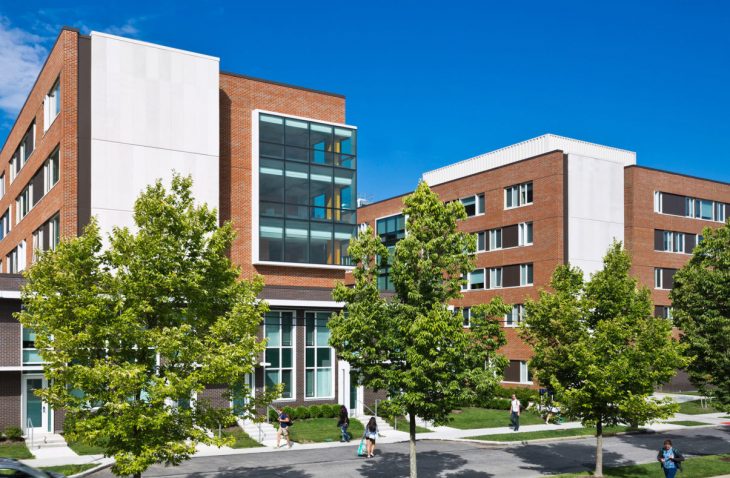New Residence Hall

IMEG provided engineering design services, as well as energy modeling, for a new five-story Residential Hall at Case Western Reserve University. The 123,200-sf Hall houses roughly 290 students in 106 apartments, ranging in size from one-bedroom to four-bedroom apartments. Additionally, the “S” shaped building includes 8 townhouse style units which house two students each. Common areas within the Hall include a main residential lounge, eight academic nodes/study lounges, laundry facilities, classroom, bike room, conference room, and a shared outdoor gathering area. The new hall accommodates growing undergraduate enrollments and is designed to provide additional on-campus rooming alternatives. The project was delivered via Design/Build.
The building had the desire for low floor to floor heights so IMEG engineers chose to frame the majority of the building with hollowcore precast spanning between shallow exterior members and interior Girder-Slab system. The GirderSlab system was cast with the grout/topping of the pre-cast to create composite steel/pre-cast to support the final loads. There were several locations where movement and deflection of the structure needed to be studied with the cladding and window systems. The entire building is supported on drill pier deep foundations.
Mechanical/plumbing systems incorporated a four-pipe chilled and hot water system to reduce energy consumption and improve the overall life cycle cost of the facility. Designs incorporated individual fan coil units per suite to promote a high level of indoor air quality with a dedicated outside air system for space ventilation. A domestic hot water heating system, public restrooms, sinks and showers, and electric water coolers, as well as necessary piping for domestic water usage was installed, as well as floor drains, floor cleanouts and wall cleanouts. Electrical systems included a new 3000A 120/208V switchboard to provide power for lighting, receptacles and mechanical equipment throughout the building and the townhouse building. All suites and townhouses have their own panelboards. Lighting was a mixture of fluorescent and LED lighting with occupancy sensors and switches. An emergency generator was installed to provide back up power for egress lighting, fire alarm, elevator and the fire pump for the emergency branch and the heating pumps, Townhouse split system units and sump pumps for the optional standby. Outdoor Lighting was LED controlled by time clocks for safety and security.
In accordance with the University’s Climate Action Plan, sustainability stood at the forefront of design choices to emphasize the University’s commitment to community, sustainability, and learning environments. Sustainable design features included energy-efficient measures such as improved envelope, improved lighting, hot water savings through low-flow fixtures, a dedicated outdoor air system with heat recovery, a high-efficiency chiller system, and others outside of engineering including storm-water retention basins, green roof terraces on the buildings and extensive landscaping with native plants. The Hall achieved 30% above ASHRAE energy performance and 36.3% energy cost savings and 13 LEED Eac1 points through its innovative design, leading the building to surpass its LEED goals and achieve LEED Gold certification. Our engineers used eQuest, a DOE2 based energy modeling software, to perform all analyses.







